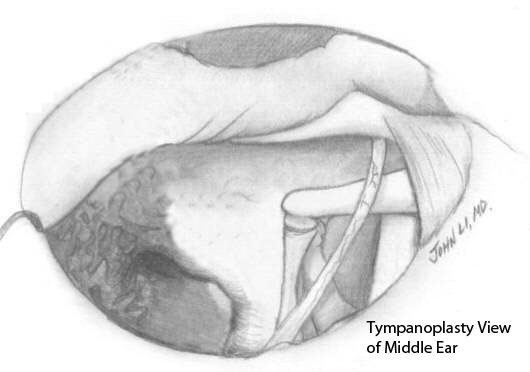


JOHN LI, M.D.
OTOLOGY NEUROTOLOGY RESOURCES
210 Jupiter Lakes Blvd #5105
Jupiter, FL 33458
Phone: (561)-748-4445
Fax: (561)-748-4449
Email: Dr-Li@Dr-Li.net
Tympanoplasty
Patient Information on Tympanoplasty and Ossiculoplasty
Tympanoplasty is a microsurgical technique used to repair broken eardrums. A small graft is obtained upon entering the ear. The graft is used to patch the hole in the ear drum.
Tympanoplasty or reconstruction of the middle ear hearing mechanism serves the purpose of rebuilding the ear drum. Ossiculoplasty refers to reconstruction of the middle ear hearing bones.
See Post Op instructions.

The procedure for a Tympanoplasty with or without Ossiculoplasty takes between 30 minutes and 2 hours, under general or local anesthesia. The approach is often noninvasively done through the ear canal, although some extensive cases require an incision behind the ear. The tiny amount of graft material usually comes from the patient's own tissue in the ear or behind the ear and is not ever noticed. The technique usually involves patching the hole from the undersurface of the drum after the hole has been prepped. The graft is sandwiched in place with dissolvable packing material and allowed to heal.
An excellent result may be expected in 90% of cases although failure to improve is not a complication. Success depends almost as much on the ability of the body to heal and preserve the reconstruction as it does on the surgeon's skill. Fortunately, even those cases that fail may be revised and have the same high degree of expected good result. As a general statement, success in restoring hearing without complication is the usual outcome in simple perforations. However, individual outcomes vary and are related to the severity of the disease present before surgery.
There are, nevertheless, some complications that do occasionally occur. Hearing loss is uncommon if the operation is limited to repairing the ear drum. Loss of sense of taste in the side of the tongue may occur. It is usually only a minor inconvenience for a few weeks. Persistent post-operative dizziness is almost unheard of after surgery limited to the repair of an eardrum perforation and uncommon after rebuilding the ear bones, although post op nausea from anesthesia is not uncommon. Injury to the facial nerve as a result of this surgery is rare. There is a slightly greater risk when mastoidectomy is also performed, but once again, the most experienced surgeons may only encounter this complication once or twice in his/her career.
Alternatives
Unless control of infection is the reason for surgery, tympanoplasty is an elective procedure. Use of a hearing aid may be an alternative to reconstructive surgery. If the ear drum perforation is not repaired, ear plugs are recommended to protect the middle ear from contamination when bathing. This may help to prevent infection and its complications.
Ossiculoplasty
Ossiculoplasty involves reconstruction of the hearing bones (ossicles). When hearing bones are eaten away by tumor, they can be replaced with natural (carved from the broken incus) or synthetic bones. These replacement bones need to be placed in proper alignment to conduct sound to the inner ear.
The most frequently damaged hearing bone is the incus. However, the other bones may be involved. There are synthetic bones that replace any combination of damage to the three natural hearing bones.
Note that the best hearing results are obtained when there is no damage to any of the hearing bones. If any of the bones need to be replaced, the final result is never as good as the original equipment. Most of the times we can get within 15 dB to 25 dB of the original hearing.
In cases where the hearing bones are not re-constructable, or when tympanoplasty and ossiculoplasty fail, BAHA implants may be indicated.